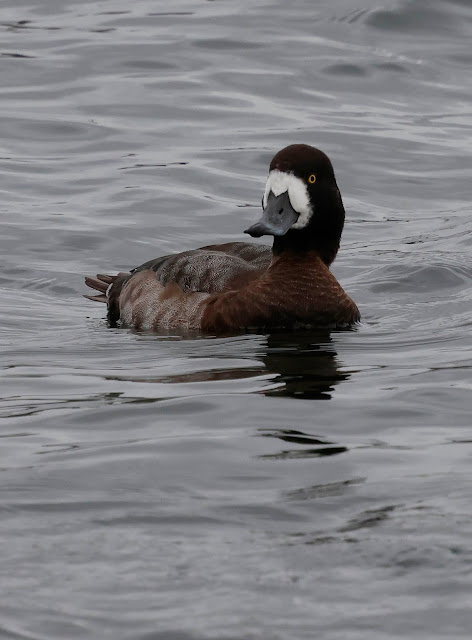I would be the last person to suggest Farmoor could bring some rare seasonal cheer apart from the fact that there is the opportunity to drink far too much coffee and eat too much cake in the reservoir's Waterside Cafe which under new ownership has blossomed into quite an attraction.
It was after having sat far too long with Phil in the cafe talking football and trying to put the world to rights that I learnt of the arrival of a Great Northern Diver on the reservoir. Great Northerns are occasional winter visitors to Farmoor, by no means annual but when one is present, adding a little bit of birding glamour amongst the usual Tufted Ducks, Great Crested Grebes, Cormorants, belligerent Coots and noisy Greylags. They can often remain for an extended period and provide some excitement as one tries to relocate it on each visit to the reservoir.
The diver currently gracing Farmoor is a juvenile as are most that arrive here. Initially it preferred to remain relatively well offshore but like the others that have preceded it in years past has become more confiding as it grows used to the human traffic on the causeway and dodging the weekend yachtsmen, windsurfers and paddle boarders on the reservoir.
Little Grebes winter in small numbers, up to a dozen, on the reservoir but do not breed here. It always strikes me as strange that such a self effacing bird opts to spend the winter exposed on the open and expansive waters of F2, the larger of the two basins. They are almost never seen on the smaller basin F1. In the breeding season they are absent from Farmoor, leaving to lead a highly secretive existence in the stands of reeds on small ponds and lakes, so why they seek the most exposed habitat available on which to spend the winter at Farmoor is a mystery.
On the reservoir they prefer to remain close to the shoreline where it is shallower.This is where the small fish such as sticklebacks and minnows on which they feed are to be found and where the grebes can dive to the bottom to catch their prey. Further out seems too deep for them. Often they can be found sheltering in the lee of the various buoys on the reservoir or hiding by the yacht club pontoons in the small marina.
Looking for all the world like circular Yorkshire Puddings and with plumage colours to match they dither around on the water, never straying far from a buoy or structure to cower beside and convince themselves they are secure.
An adult female Greater Scaup has been at the reservoir for well over two months now, consorting with the wintering flock of mainly male Tufted Ducks, following the flock as it moves from one basin to the other. It is always in a loose company with 'the tufties' and rarely found on its own.When asleep, which is its default behaviour, and at some distance offshore it can be difficult to separate from other sleeping female Tufted Ducks around it. The diagnostic white circle around its bill is hidden as the bill is tucked into its mantle feathers but careful examination of its plumage reveals an ashy grey wash to the brown upperparts and paler flanks than on a female Tufted. It is also marginally larger and broader in the beam than the Tufteds which is also a giveaway to its identity.
This bird may well be the one which spent last winter here and there is always hope it might attract others. Although unlikely it did happen one year when a male, female and juvenile spent the winter together on the reservoir.
For the last three years a Common Sandpiper has spent the winter at the reservoir.Normally they head for Africa but possibly the warming climate has allowed a bird that needs winter warmth and a plentiful supply of invertebrates, to tough it out through the worst of our winter. Farmoor is probably as good a bet as any to chance its luck as there are always insects along the water's edge.
I doubt it is the same individual that has been here three years running but who knows. Common Sandpipers at Farmoor on spring and autumn migration are notoriously wary and fly before you can get anywhere near them but this bird allows relatively close approach which may be a sign it is struggling to find food and has not the will to flee but rather concentrate on finding as much sustenance as possible in these short days of winter.
Near the reservoir, by a busy road running along the north side of Farmoor Village, a flock of no less than twenty one Cattle Egrets have been feeding in the grass fields of a dairy farm for the last two or three days. Like a line of errant washing the egrets spread out across the fields hunting for food in the grass. The whiteness of their plumage gains a luminosity in the sun, possessing a purity and intensity far beyond that of any gull.
Ten years ago I would have been dreaming if I thought I would be looking at a flock of Cattle Egrets feeding in a field. in the middle of England. in the depths of winter.
How times have changed.
So this week, by Farmoor's undemanding standards, has proved exceptional and hopefully other 'good' birds may follow in the coming months. Somehow I doubt it but eternal hope and an unflinching optimism goes with the territory at Farmoor Reservoir these days.
Happy Christmas everyone.

















Happy Christmas Ewan, and thank you for your delightful posts.
ReplyDeleteLikewise Colin. It can only get better!
Delete